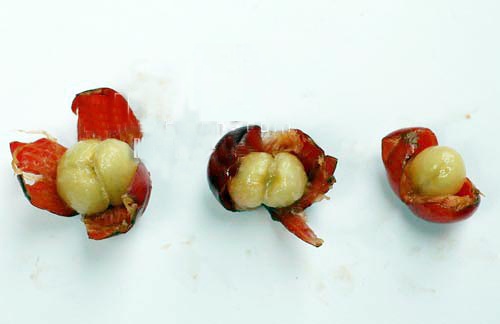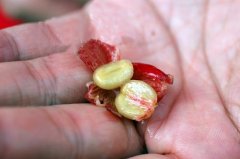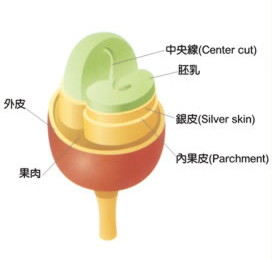Coffee bean planting coffee bean seed coffee raw bean price Indonesia Sumatra Aceh province 19 items
Coffee seeds cannot be grown directly with coffee fruits picked from coffee trees. Peeling coffee fruits is just like planting peanuts. If you plant a peanut with a shell in the soil, it cannot sprout. You must plant peanuts. It is the same with medium coffee. If you have coffee fruit in your hand, you can bask it in the sun first and shake it until it is shaken. (like sun-dried peanuts), you can peel off the shell of the coffee fruit and plant it with coffee seeds inside. Coffee trees must be planted near the equator in the tropics and subtropics at latitudes 23 °N and 25 °S. In China, only Taiwan, Hainan and Yunnan can grow coffee trees.
The cultivation of coffee beans
Indoor growth is best placed in a place with plenty of light. Non-direct sunlight or fluorescent lighting such as an office or kitchen has good light conditions.
(watering)
Place the tree in a sink or container and water until water leaks from the drain at the bottom of the basin. Repeat this step until all the roots are wet. It is usually OK to water it once a week. Don't keep the soil wet all the time. Don't water too much! To avoid getting too wet, keep the water tray under the flowerpot dry.
(fertilization)
You can buy liquid fertilizer from the horticultural shop and fertilize it according to the method of indoor plants.
(temperature)
Coffee is a subtropical plant, growing at about 61F ~ 74F (16C ~ 23C). It can withstand temperatures of about 55F (12C) to 80F (27C) and still bloom. Don't let it get cold! If you put it in the sun or in a hot place, water more so as not to wither the plants.
Country: Indonesia
Grade: G1BI 19 items +
Producing area: Gayo Mountain area of Aceh Province
Altitude: 1100-1300 m
Treatment method: traditional wet planing method
Variety: Katimo, Kaddura, Tibika, Sidikalong
Producer: local small farmers in the Gayo Mountains
Flavor: round and pure taste, mellow thickness, spices, herbs
Indonesian coffee is very diverse in quality, most of which are based on the island origin as its market name: such as Sumatra, Sulawesi, Jawa or Timur. The advantage of Indonesian coffee is that most coffee is characterized by strong, introverted flavor and lively moderate acidity. Chinese people think highly of Indonesian Mandheling coffee, and it is one of the coffee products with the highest acceptance of single coffee.
Indonesia Mandheling was once praised as the best unique wet peeling coffee bean in the world. Mantenin is a trademark merchandise. Nowadays, as long as the red cherry fruit of coffee harvested in Indonesia is processed by this unique wet peeling method, it will be sold as Mantenin coffee beans. Mandailing grew coffee from the Tapanuli region of northwestern Sumatra, because at the end of World War II, a Japanese soldier introduced the Japanese market and changed the wrong Mandailing into Mandheling coffee because of mispronunciation.
Sumatra (Sumatra):
Coffee in Sumatra is very complex and elusive. Although Sumatra is large, coffee is not grown all over the island. Coffee trees are grown in only the two northernmost provinces of the island's eight provinces, Aceh and Jiangsu: Aceh coffee is mainly produced in the GayoMountain mountains around Lake LakeTawar, and most of the farmers in this area are local GayoPeople aborigines. On the other hand, coffee in Jiangsu Province is mainly produced in the world's largest super crater lake-LakeToba Lake (Tuba Lake) and south Lindong (Lintong) producing area, and the local farmers are mostly composed of BatakPeople aborigines. Due to many sharecropper producers and the use of their unique semi-washing treatment and lack of iron in the soil, coffee beans in this area have a special blue color at the stage of fresh beans.

Important Notice :
前街咖啡 FrontStreet Coffee has moved to new addredd:
FrontStreet Coffee Address: 315,Donghua East Road,GuangZhou
Tel:020 38364473
- Prev

Coffee Bean Planting Coffee Bean Seeds Coffee Green Bean Indonesia Bali Kalana Quinta Mani Fire
Coffee seeds can not be directly picked from the coffee tree coffee fruit, to the coffee fruit shell, just like planting peanuts, if you put a peanut shell into the soil, it is not germinating, must be planted peanuts, coffee is the same, if you have coffee fruit, you can put it in the sun, has been shaken up inside will
- Next

Coffee beans grow coffee beans seeds coffee raw beans Papua New Guinea A grade water washed pearl balls
Coffee seeds cannot be grown directly with coffee fruits picked from coffee trees. Peeling coffee fruits is like planting peanuts. If you plant a peanut with a shell in the soil, it cannot sprout. You must plant peanuts. It is the same with medium coffee. If you have coffee fruit in your hand, you can first bask it in the sun and shake it until it is shaken inside.
Related
- Detailed explanation of Jadeite planting Land in Panamanian Jadeite Manor introduction to the grading system of Jadeite competitive bidding, Red bid, Green bid and Rose Summer
- Story of Coffee planting in Brenka region of Costa Rica Stonehenge Manor anaerobic heavy honey treatment of flavor mouth
- What's on the barrel of Blue Mountain Coffee beans?
- Can American coffee also pull flowers? How to use hot American style to pull out a good-looking pattern?
- Can you make a cold extract with coffee beans? What is the right proportion for cold-extracted coffee formula?
- Indonesian PWN Gold Mandrine Coffee Origin Features Flavor How to Chong? Mandolin coffee is American.
- A brief introduction to the flavor characteristics of Brazilian yellow bourbon coffee beans
- What is the effect of different water quality on the flavor of cold-extracted coffee? What kind of water is best for brewing coffee?
- Why do you think of Rose Summer whenever you mention Panamanian coffee?
- Introduction to the characteristics of authentic blue mountain coffee bean producing areas? What is the CIB Coffee Authority in Jamaica?

